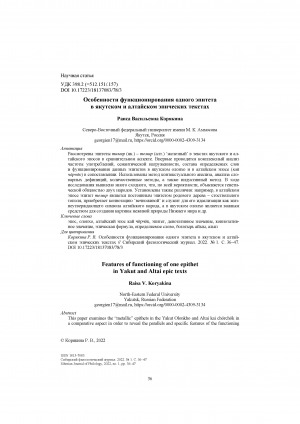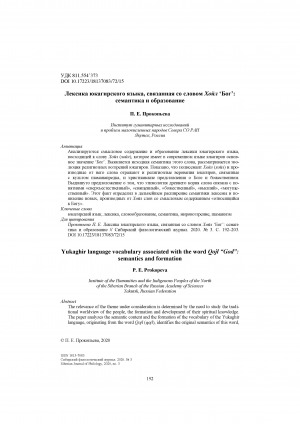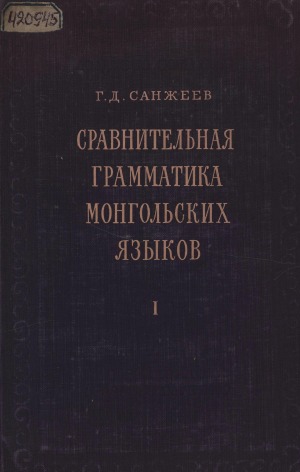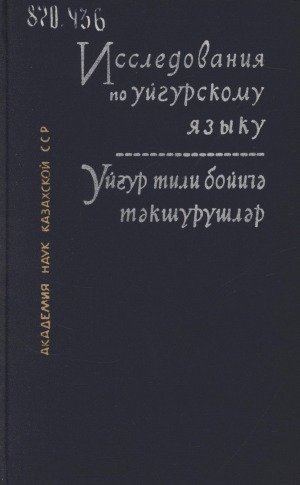- Бурятский (1)
- Чукотский (8)
- Долганский (8)
- Английский (34)
- Эвенкийский (35)
- Эвенский (37)
- Французский (11)
- Немецкий (5)
- Хантыйский (1)
- Корякский (2)
- Нанайский (4)
- Нивхский (3)
- Старорусский (2)
- Русский (1921)
- Латинская графика (29)
- Тунгусский (2)
- Турецкий (16)
- Тувинский (2)
- Якутский (319)
- Юкагирский (14)
Количество страниц: 12 с.
- Общественные науки. Образование > Народное образование. Воспитание. Обучение. Организация досуга > Общеобразовательная школа. Дошкольные учреждения,
- Языкознание. Филология. Художественная литература > Языкознание и языки. Лингвистика > Эвенкийский язык,
- НАУКА ЯКУТИИ > ЯЗЫКОЗНАНИЕ. ФИЛОЛОГИЯ. ЛИТЕРАТУРОВЕДЕНИЕ. ХУДОЖЕСТВЕННАЯ ЛИТЕРАТУРА > Языкознание и языки. Лингвистика,
- НАУКА ЯКУТИИ > ОБЩЕСТВЕННЫЕ НАУКИ > Народное образование. Воспитание. Обучение. Организация досуга > Общеобразовательная школа. Дошкольные учреждения.
The main purpose of the study was to analyze the lexical units involved in the representation of the URE ‘mountain’ concept in the language picture of the world of the Evenks. The identification of word meanings involved the examination of bilingual dictionaries of the Evenk language and field records of authentic texts narrated by informants who knew the Evenk and Russian languages well. According to the source study, the lexemes ure , a , and are the most commonly used representations of the concept URE in the Evenks’ world picture. The analysis revealed the meaning of lexemes ure , a , and allowed their semes to be identified. The ure lexeme was found to have the semes: ‘overgrown with trees,’ ‘low hill,’ ‘inhabited by moose, bears, and other wild animals,’ and ‘master spirit of the mountain.’ The following semes were found for the lexeme : ‘stony,’ ‘covered with grass or reindeer moss,’ ‘inhabited by wild deer,’ ‘suitable for residence in summer,’ suitable for roaming,’ ‘suitable for deer grazing in summer,’ and ‘a good place for hiding deers from wolves.’ The lexeme is characterized by the semes: ‘rocky,’ ‘high,’ ‘made of stones,’ ‘cool place,’ and ‘inhabited by bighorn sheep, tarbagans, and musk deer.’ A conclusion is made that the URE ‘mountain’ concept formation was influenced by Evenks’ hunting and nomadic lifestyle combined with their animistic views on nature. The URE ‘mountain’ concept is a part of the BUGA ‘world’ concept structure.
Ушницкая, Н. Ю. Репрезентация концепта УРЭ ‘гора’ в языковой картине мира эвенков / Н. Ю. Ушницкая ; Институт гуманитарных исследований и проблем малочисленных народов Севера // Сибирский филологический журнал. - 2023. - N 4. - С. 287-298. - DOI: 10.17223/18137083/85/21
DOI: 10.17223/18137083/85/21
Количество страниц: 14 с.
The paper presents a structural description of the terminological phrases relating to the thematic group “Livestock body parts” in the Yakut and Buryat languages. These lexical units refer to the folk terms reflecting the features of the material and spiritual culture of an ethnic group and are widely used in languages of very different typologies. Such phrases are formed analytically, representing non-single-word nominative units denoting one specific concept or real object. Their lexical meaning can be realized at the denotative and/or connotative levels. The terminological phrases under study occupy a special place in the lexicon of the languages in question as an effective way of creating terms. Word pairs are a part of this vocabulary group. An active way of compound word formation in Yakut and Buryat is the method of adjunction used to form attributive phrases with an adjective or a participle as an attribute. Both languages feature terminological phrases formed morphologically. Such phrases have an attributive function, designating a part of a whole object or a type of a generic concept, with the determining component occupying the preposition. In Yakut, these phrases have their components connected by the possessive affix of the third person. Buryat terms denoting animal body parts are formed by a combination with the determining component in the genitive case. It is noteworthy that in Yakut nominal constructions, the indicator of the connection between the components is attached to the component being determined, while in Buryat, it is attached to the determining one.
Данилова, Н. И. Терминологические словосочетания, обозначающие части тела скота, в якутском языке (в сопоставлении с бурятским) / Н. И. Данилова, Ф. Н. Дьячковский ; Институт гуманитарных исследований и проблем малочисленных народов Севера // Сибирский филологический журнал. - 2023. - N 4. - С. 197-210. - DOI: 10.17223/18137083/85/15
DOI: 10.17223/18137083/85/15
Количество страниц: 14 с.
This paper addresses the semantics of dialectal names of mutovka (a stick with branches at the end used for mixing or stirring), with all of them belonging to the lexical-thematic microgroup “Utensils” in the Yakut language. Over 40 dialect names of mutovka with different connotations have been identified in dialectological, lexicographical, and ethnographic materials. The nomination principles of mutovka are determined on the external form and functions. The form and structure of mutovka s (round, branched, cross-shaped), material (wood, cow horn) depend on their purpose. Mutovka has different functions: for whipping koumiss, cream, or butter, and others, with the movement of the tool also of importance for nomination. The basic characteristic of any mutovka is ytyyyy “mixing, stirring, and churning.” The comparative analysis revealed that the Yakut lexemes ytyk and bhiheyeh indicate a common Turkic similarity. Most names of mutovka are part of the lexical fund of the Yakut language developed in the linguistic landscape of modern Yakuts (Sakha). Also, the dialect names bilier, biriel “kumys mutovka” have been found to have Mongolian roots. A semantic description allowed the origin of khamnatar “kumys mutovka” to be determined as an apotropaic lexeme with both all-Yakutian and dialectal meaning. The semantics of the mutovka names concerned reflects the cattle-breeding culture of Yakuts (Sakha) developed and spread in the subcontinental climate in the vast territory of the North-East of Russia. The findings specify the lexical-semantic microgroups “Tableware,” “Utensils” to “Kumys ware and utensils,” “Ytyk,” to compile the thematic lists of Yakut household culture.
Николаев, Е. Р. Диалектные наименования мутовки в якутском языке (на материале лексикографических источников) / Е. Р. Николаев ; Институт гуманитарных исследований и проблем малочисленных народов Севера // Сибирский филологический журнал. - 2023. - N 2. - С. 194-207. - DOI: 10.17223/18137083/83/15
DOI: 10.17223/18137083/83/15
Количество страниц: 12 с.
- Языкознание. Филология. Художественная литература > Языкознание и языки. Лингвистика > Якутский (саха),
- Языкознание. Филология. Художественная литература > Языкознание и языки. Лингвистика > Другие языки,
- НАУКА ЯКУТИИ > ЯЗЫКОЗНАНИЕ. ФИЛОЛОГИЯ. ЛИТЕРАТУРОВЕДЕНИЕ. ХУДОЖЕСТВЕННАЯ ЛИТЕРАТУРА > Языкознание и языки. Лингвистика.
This paper examines the “metallic” epithets in the Yakut Olonkho and Altai kai chӧrchӧk in a comparative aspect in order to reveal the parallels and specific features of the functioning of these epithets in the epic of peoples related in the historical past. The following methods were used: contextual analysis, analysis of dictionary definitions, quantitative methods, and the inductive method, which allows generalizing the results of applying all the methods. The comparative study revealed many similarities. In both epics, metal epithets in the structure are radical, derived from the lexeme denoting the name of the metal. In a denotative meaning, they characterize objects by the material from which they are made. The choice of specific metallic epithets as contextual synonyms in the structure of the epic formula is due to the phenomenon of vowel harmony inherent in most Turkic languages. The genetic community of the Yakut and Altai peoples probably explains the similar features of the metallic epithets. Also, the differences have been established: according to the frequency of using the epithets formed from the nominations of precious metals, the ancient Yakuts preferred silver, and the Altai people preferred gold. The differences and peculiarities of functioning of “metal” epithets in the Yakut and Altai epic texts can be explained by the stage difference in the development of the epic texts compared.
Корякина, Р. В. Особенности функционирования одного эпитета в якутском и алтайском эпических текстах / Р. В. Корякина ; Северо-Восточный федеральный университет им. М. К. Аммосова // Сибирский филологический журнал. - 2022. - N 1. - С. 36-47. - DOI: 10.17223/18137083/78/3
DOI: 10.17223/18137083/78/3
Количество страниц: 12 с.
The relevance of the theme under consideration is determined by the need to study the traditional worldview of the people, the formation and development of their spiritual knowledge. The paper analyzes the semantic content and the formation of the vocabulary of the Yukaghir language, originating from the word Qojl (qojl), identifies the original semantics of this word, examines the evolution of the religious beliefs of the Yukaghir. The word Qojl (qojl) is associated originally with shamanistic beliefs and was representing the image of the shaman-patron of the family in the traditional culture of the Yukaghir. Later, it came to be referred to the name of the Christian God and to designate icons and saints. In the modern Yukaghir language, the word concerned is used only in the meanings of “God,” “divinity,” “icon,” “saint.” The prevalence of Qojl (qojl) - derived words in the languages of two local Yukaghir groups, the similarity of the structure and meanings of many of the lexemes indicate the archaicity of the word and the presence of a semantic relationship between the original and late sememes. An assumption has been made that the etymology of the ancient root of the word is associated with the concepts of “supernatural,” “sacred,” “divine,” “supreme,” “powerful.” The fact that the word originally comprised the concept of the supernatural and divine determined the expansion of the semantics of the word. Under the influence of Christianity, new words derived from Qojl ( qojl ), with the semantic content “referring to God,” appear in the Yukaghir language.
Прокопьева, П. Е. Лексика юкагирского языка, связанная со словом Хойл ‘Богʼ: семантика и образование / П. Е. Прокопьева ; Институт гуманитарных исследований и проблем малочисленных народов Севера СО РАН // Сибирский филологический журнал. - 2020. - N 3. - С. 76-80. - DOI: 10.17223/18137083/72/15
DOI: 10.17223/18137083/72/15
Количество страниц: 18 с.
From the card index “Phraseologisms characterising a human being in Yakut and Turkic languages of South Siberia, Turkish and Kazakh” compiled by the author, 75 lexeme-mongolisms in the Yakut language were identified. This article is the first special study of these lexemes-mongolisms, which are part of Yakut phraseologisms (somatisms; lexemes denoting objects of material culture). The aim of this study is to identify the area of distribution of Mongolisms included in Yakut phraseological phrases, to establish phraseological parallels in other Turkic languages, to determine the motivational bases of phraseological phrases characterising human beings. Thus, to make a certain contribution to the clarification of the problem of Yakut-Mongolian contacts. The value of phraseologisms lies in the fact that remaining unchanged, they preserve national identity and reflect the characteristic features of the historical epoch in which they originated. The study of Mongolisms in the Yakut language is based on the scientific works of E.I. Ubryatova, S. Kaluzhinsky, V.I. Rassadin, N.N. Shirobokova, N.K. Antonov, G.G. Levin, A.E. Shamaeva and others. As a result of the study, it was established that: Mongolisms included in Yakut phraseologisms can be subdivided into the following types - a) Mongolisms borrowed by the Turkic-speaking ancestors of the Yakuts back in the times when they lived in the “southern” ancestral homeland; b) Mongolisms previously acquired in the “southern” ancestral homeland as part of the Turkic Kypchak component; c) Mongolisms that penetrated already in geographically separated groups of Turkic languages from certain Mongolian languages; d) Mongolisms acquired through an “unknown” Middle Mongolian source language and/or Buryat language. The overwhelming majority of the considered Yakut phraseologisms with Mongolian components do not find parallels in the Turkic languages, which confirms the thesis that the formation of these phraseologisms took place in the process of their development under conditions of non-contact with the Turkic languages of South Siberia. The prospects of the study are seen in further reconstruction of the phraseological fund of the Yakut language in order to make a significant contribution to the solution of the problem of Yakut-Mongolian contacts.
Анисимов, Р. Н. Монгольские компоненты в составе якутских фразеологизмов, характеризующих человека (сравнительно-сопоставительный аспект) / Р. Н. Анисимов ; Северо-Восточный федеральный университет им. М. К. Аммосова // Вестник Северо-Восточного федерального университета им. М. К. Аммосова. - 2024. - Т. 21, N 1 (95). - С. 98-115. - DOI: 10.25587/2222-5404-2024-21-1-98-115
DOI: 10.25587/2222-5404-2024-21-1-98-115
Издательство: Академии наук СССР
Год выпуска: 1953
Серия, номер выпуска: Т. 1
Количество страниц: 250 с.
Издательство: Наука
Год выпуска: 1970
Серия, номер выпуска: Ч. 2
Количество страниц: 182 с.
Издательство: Наука, Ленинградское отделение
Год выпуска: 1971
Количество страниц: 412 с.
Издательство: Наука
Год выпуска: 1974
Количество страниц: 352 с.









